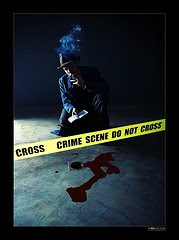
Last week the Boston chapter of the SIKMers riffed on a recent op-ed polemic by David Weinberger, one of KM's most lucid and original explainers. His case that transparency is the new objectivity argues that objectivity and objectives part company as soon as the subject climbs into the ring to greet the predicate.
This false god of objectivity has a familiar din in the blogosphere where the only distinction between a PR hack and a venerated journalist is whether they count a media conglomerate on their pay stub or the client retains them directly. Weinberger moves smartly beyond the tired trashing of media elites to the more complex unpacking of what it means for: (1) defining the boundaries of context, and (2) ultimately the quality of information grown and cultivated on the public web.
He notes that "fair and balanced" is unattainable for reporters and all second-party relayers of primary events. From fact collectors to checkers and from theory rejectors to truth selectors we hold this truth to be transparent -- that all humans create subjective realities. But then Weinberger sources the downstream implications for retiring this myth: (1) Its tendency to overstep its own authority, and (2) its coercive power to mislead those it seeks to inform with its self-referential perspective.
Can reasonable people seeking the refuge of a higher ground still find their way to a common, middle ground? Weinberger goes onto conclude that the achievement of objectivity is not only widely questioned but dismissed as an agreed-upon goal between senders and receivers (or what used to be called "the media" and "the public.") Yet the myth lives on. Why?
Even our well-intended skepticism cannot conceal another gaping need once (and still) serviced by the myth. And it has little to do with column widths, how many people still read newspapers, or how many of us document what we say and think based on what we see and hear. That insistent need in the mind of the news beholder is credibility -- the emerging gold standard of information overload. Only through the lens of credibility can we buy arguments, accept a premise, or decide who's right between the fraying edges of our national discourse.
Now that the limits of objectivity are on full display in our search results and our cable systems Weinberger argues that transparency is the new surrogate for credibility, ready to step in and referee for the brave and free inquirers and deciders of all spectral stripes:
That’s one sense in which transparency is the new objectivity. What we used to believe because we thought the author was objective we now believe because we can see through the author’s writings to the sources and values that brought her to that position. Transparency gives the reader information by which she can undo some of the unintended effects of the ever-present biases. Transparency brings us to accept ideas as credible the way the claim of objectivity used to.
This change is epochal.
In this world the biases are stripped away. Don't take the reporter's word on it? Click through to their sources and question what was pursued and what went begging. The blind-spots blink right back at us. The truth is stripped down to its naked accessories, made all the more discomforting by conclusions reached before any reporting ever takes place. Of course that level of open documentation assumes an audience as active in their news consumption as the reporter in the production of their story. Only a third-party with a firsthand stake of an outcome proposed or influenced in the reporting would exercise their full transparency options.
It's also sobering to consider the lengths that reporters have gone to protect their sources in this new golden age of transparency -- precisely because the story could stand on its own through the testimony and firsthand experience of those troubled by their own confirming observations.
That's the sniff test for credibility whether it's delivered through myth or hyperlink. When we open ourselves up to persuasion how much of our heads run interference for our hearts? How scripted is the appeal? How self-serving to the caller is the call for all good humans to come to the aid of the unaided? Bottom-line: what is this costing them -- particularly among members of their own group in untold horse trading and political capital?
We see things not as they are but as we are. The greatest threat to public credibility is 'politics as usual' -- the extent to which power protects itself regardless of the laws, morals, public trust, and, loyalties it compromises. How our leaders behave in public is routinely compared to our perception of the way they act behind closed doors. The gap between what we 'see' and what we're 'told' forms the basis of 'character'. We know them so we accept what we cannot understand. Our leader is a jerk. But they are 'our' jerk.
Public leaders with strong character are said to resist politics as usual -- sacrificing their own grip on power for the greater public good, a higher principle, and/or, the belief that such a sacrifice will prompt greater beneficence among other participants, including adversaries. That kind of trading is called integrity. It is the highest form of credibility -- and the rarest.
My hope from Weinberger's insights is not that transparency will even the playing field or cast a redeeming light in a dark corner but simply 'be' the playing field. We will not all play by the same rules. But neither will the eyes of the world look away when we're drawn to that harsh, clarifying spotlight.








